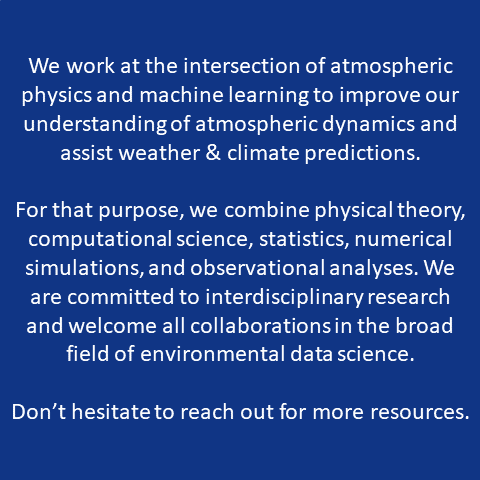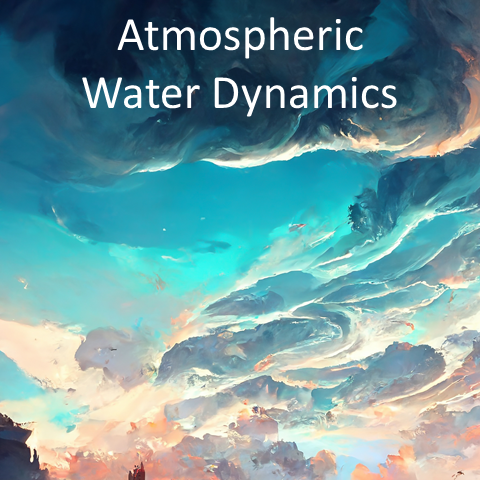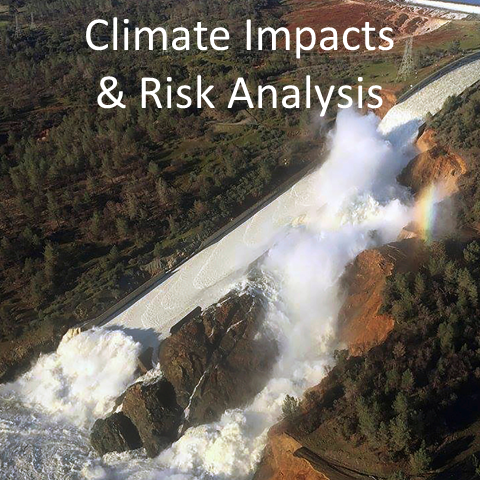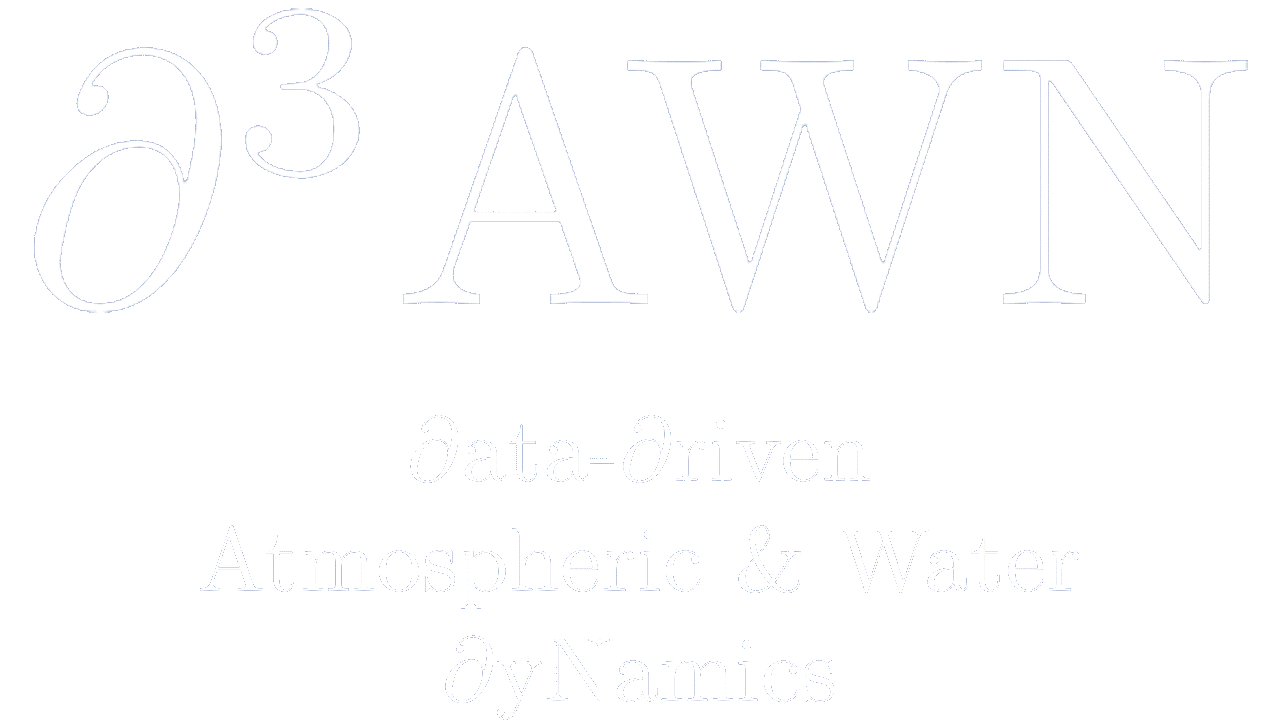









Physics-Guided Machine Learning for Climate Modeling
Understanding and combating the climate crisis is of paramount importance. The challenge of simultaneously simulating clouds and planetary-scale winds has been a key reason for uncertainty in future climate predictions, and it is unlikely that we will routinely run such simulations before 2050. Machine-learning algorithms trained on storm-resolving models run for shorter time periods can mimic the statistical effects of fine-scale clouds in less expensive climate models, and this is already accelerating climate modeling. However, statistical algorithms on their own have deficiencies that prevent their adoption by the climate community. Physical (theory-driven) modeling and machine-learning (data-driven) modeling have traditionally been treated as independent approaches, but recent progress in stochastic optimization allows training of machine-learning models with both flexible architectures and loss functions that can incorporate physical knowledge.
Our research has combined atmospheric physics and deep learning to address key shortcomings of neural-network (NN) models of convection and clouds because NNs are powerful non-linear regression tools, well-suited for high-dimensional problems and large datasets. First, unconstrained NNs typically violate mass and energy conservation laws, leaking energy at a rate that compromises long-term climate predictions. We developed methods to modify a NN’s architecture so as to enforce mass and energy conservation to within machine precision, which we then generalized to enforce non-linear constraints in any NN emulating a physical system. Second, NNs are hard to interpret and often cause instability when coupled to atmospheric fluid dynamics. We customized machine learning interpretability tools to improve the transparency and stability of NN models of convection. Third, NNs make large errors when evaluated out-of-distribution, e.g. in the Tropics of a warmer climate. We demonstrated that physically rescaling a NN’s inputs and outputs allowed the NN to make reasonable predictions in a different climate and in regions of the atmosphere it had not been trained on. Most recently, we formalized this framework to help machine learning algorithms maintain high accuracy across a wide range of climates and geographies in three distinct climate models.
(2024) Iglesias-Suarez, F., P. Gentine, B. Solino-Fernandez, T. Beucler, M. Pritchard, J. Runge & V. Eyring: Causally-informed deep learning to improve climate models and projections. Journal of Geophysical Research: Atmospheres, 129, e2023JD039202 [pdf].
(2024) Beucler, T., P. Gentine, J. Yuval, A. Gupta, L. Peng, J. Lin, S. Yu, S. Rasp, F. Ahmed, P. O’Gorman, D. Neelin, N. Lutsko & M. Pritchard: Climate-Invariant Machine Learning. Science Advances, 10, eadj7250 [pdf].
(2024) Beucler, T.: Atmospheric physics-guided machine learning for climate modeling and weather forecasting. US CLIVAR PPAI Webinar.
(2023) (Workshop) Lin, J., M. A. Bhouri, T. Beucler, S. Yu & M. Pritchard: Stress-testing the coupled behavior of hybrid physics-machine learning climate simulations on an unseen, warmer climate. 2023 Conference on Neural Information Processing Systems.
(2023) Zanetta, F., D. Nerini, T. Beucler & M. Liniger: Physics-constrained deep learning postprocessing of temperature and humidity. Artificial Intelligence for the Earth Systems, 2, e220089. [pdf]
(2023) (NeurIPS 2023 Conference) Yu, S., W. Hannah, L. Peng, M. Bhouri, R. Gupta, J. Lin, B. Lütjens, J. Will, T. Beucler et al.: ClimSim: A large multi-scale dataset for hybrid physics-machine learning climate emulation. Advances in Neural Information Processing Systems. “Oustanding Datasets and Benchmarks” award. [pdf]
(2022) Grundner, A., T. Beucler, P. Gentine, F. Iglesias-Suarez, M. Giorgetta & V. Eyring: Deep Learning Based Cloud Cover Parameterization for ICON. Journal of Advances in Modeling Earth Systems, e2021MS002959. [pdf]
(2022) Beucler, T.: Climate-Invariant Machine Learning. AGCI Workshop on “Exploring the Frontiers in Earth System Modeling with Machine Learning and Big Data”
(2022) Beucler, T.: Atmospheric Physics-Guided Machine Learning. IXXI Conference on ML and sampling methods for climate and physics (short version here from AMLD)
(2022) Beucler, T.: Physics-Guided and Causally-Informed Machine Learning for Climate Modelling. ECMWF Machine Learning Workshop
(2021) Mooers, G., M. Pritchard, T. Beucler, J. Ott, G. Yacalis, P. Baldi & P. Gentine: Assessing the Potential of Deep Learning for Emulating Cloud Superparameterization in Climate Models with Real-Geography Boundary Conditions. Journal of Advances in Modeling Earth Systems, 13, e2020MS002385. [pdf]
(2021) Beucler, T., M. Pritchard, S. Rasp, J. Ott, P. Baldi & P. Gentine: Enforcing Analytic Constraints in Neural-Networks Emulating Physical Systems. Physical Review Letters, 126.9: 098302. Editors’ Suggestion. [pdf]
(2020) Brenowitz, N., T. Beucler, M. Pritchard & C. Bretherton: Interpreting and Stabilizing Machine-Learning Parametrizations of Convection. Journal of the Atmospheric Sciences, 77, 4357-4375.
(2020) (Workshop) Beucler, T., M. Pritchard, P. Gentine & S. Rasp: Towards Physically-Consistent, Data-Driven Models of Convection. IEEE International Geoscience and Remote Sensing Symposium 2020. [pdf]
(2020) Beucler, T.: Climate-Invariant Nets: Physical Rescalings Help NNs Generalize to Out-of-sample Climates. SIAM Mathematics of Planet Earth 2020
(2020) Beucler, T.: Towards Physically-Consistent, Data-Driven and Interpretable Models of Convection. NOAA STAR Artificial Intelligence Seminar
(2020) Beucler, T.: Building a Hierarchy of Hybrid, Neural Network Models of Convection. 100th American Meteorological Society Annual Meeting
(2019) (Workshop) Beucler, T. S. Rasp, M. Pritchard & P. Gentine: Achieving Conservation of Energy in Neural Network Emulators for Climate Modeling. 2019 International Conference on Machine Learning.

AI for Tropical Meteorology
(Submitted) Tam, F. I,, T. Beucler & J. Ruppert: Identifying Three-Dimensional Radiative Patterns Associated with Early Tropical Cyclone Intensification.
(2023) Ganesh S., S., T. Beucler, F. I. Tam, M. Gomez, J. Runge & A. Gerhardus: Selecting Robust Features for Machine-Learning Applications using Multidata Causal Discovery. Environmental Data Science, 2: e27. [pdf]
(2023) Beucler, T. & M. McGraw: AI for tropical meteorology: Challenges and opportunities. ITU“AI for Good” seminar series.

Data-Driven Scientific Discovery
(2024) Grundner, A., T. Beucler, P. Gentine & V. Eyring: Data-Driven Equation Discovery of a Cloud Cover Parameterization. Journal of Advances in Modeling Earth Systems, 16, e2023MS003763 [pdf].
(2023) Mooers, G., M. Pritchard, T. Beucler, P. Srivastava, H. Mangipudi, L. Peng, P. Gentine & M. Pritchard: Comparing Storm Resolving Models and Climates via Unsupervised Machine Learning. Scientific Reports. [pdf]
(2023) Beucler, T.: Generating Climate Model Hierarchies from Data using ML. Core Science Keynote, 103rd AMS Annual Meeting.
(2022) Wu, Z., T. Beucler, E. Székely, W. Ball & D. Domeisen: Modeling Stratospheric Polar Vortex Variation and Identifying Vortex Extremes Using Explainable Machine Learning. Environmental Data Science 1: e17. [pdf]
(2022) Behrens, G., T. Beucler, P. Gentine, F. Iglesias-Suarez, M. Pritchard & V. Eyring: Non‐Linear Dimensionality Reduction with a Variational Encoder Decoder to Understand Convective Processes in Climate Models. Journal of Advances in Modeling Earth Systems, e2022MS003130. [pdf]
(2021) (Workshop) Mangipudi, H., G. Mooers, M. Pritchard, T. Beucler & S. Mandt: Analyzing High-Resolution Clouds and Convection using Multi-Channel VAEs. 2021 Conference on Neural Information Processing Systems.
(2020) (Workshop) Mooers, G., J. Tuyls, S. Mandt, M. Pritchard & T. Beucler: Generative Modeling of Atmospheric Convection. Proceedings of the 10th International Conference on Climate Informatics, 98-105. [pdf]

(2014-2020) Interaction between Water Vapor, Radiation and Convection in the Tropics
The interaction between the fast ascending motion of light air that produces clouds and storms (atmospheric convection) and large-scale winds is a primary source of uncertainty in numerical simulations of the atmosphere, impeding our understanding of the climate. At the beginning of my Ph.D., a salient problem caught my attention: When high-resolution atmospheric models were run to radiative-convective equilibrium (the simplest model of the tropical atmosphere capable of realistic temperature and water vapor predictions), strong storms spontaneously clustered together to form compact moist regions. While the research community agreed this “self-aggregation” of convection was not a numerical artifact, its physical mechanisms and applicability to the real world were still disputed.
Motivated by this opportunity to close the gap between numerical simulations, theory, and observations, we used simple radiative models to hypothesize that the observed atmosphere was humid enough for “self-aggregation” to occur almost everywhere in the real Tropics. The inability of simple theories to capture the spatial variability of tropical atmospheric water sparked my interest in data science; instead of proposing an additional theory for the size of moist and dry regions in the Tropics, we adapted spectral methods to quantify the role of radiation, surface fluxes, and advection in organizing water vapor objectively at each spatial scale from terabytes of cloud-resolving model, global storm-resolving model, and observational data. Systematically bridging atmospheric physics theory and observations via the creation of diagnostic data analysis tools is now a cornerstone of my research philosophy, and we recently leveraged theory from statistical physics to formulate a new index that can quantify the convective aggregation of both observed tropical rainbands and idealized storm clusters.
(2020) Beucler, T.: Comparing Convective Self-Aggregation in Models to Obs. MSE Variability. 100th American Meteorological Society Annual Meeting
(2019) Beucler, T., T. Abbott, T. Cronin & M. Pritchard: Comparing Convective Self‐Aggregation in Idealized Models to Observed Moist Static Energy Variability Near the Equator. Geophysical Research Letters, 46, 17-18. [pdf]
(2019) (Thesis) Beucler, T.: Interaction between Water Vapor, Radiation and Convection in the Tropics. Ph.D. Thesis in Atmospheric Science.
(2018) Beucler, T. & T. Cronin: A Budget for the Size of Convective Self-Aggregation. Quarterly Journal of the Royal Meteorological Society, 145, 947-966.
(2018) Beucler, T., T. Cronin & K. Emanuel: A Linear Response Framework for Radiative-Convective Instability. Journal of Advances in Modeling Earth Systems, 10(8), 1924-1951.
(2018) Beucler, T.: A Spectral Budget for the Size of Convective Self-Aggregation. 33rd Conference on Hurricanes and Tropical Meteorology
(2017) Beucler, T.: A Moist Static Energy Perspective on Atmospheric Rivers. 17th Conference on Mesoscale Processes
(2017) Beucler, T.: The Vertical Structure of Radiative-Convective Instability. 21st Conference on Atmospheric and Oceanic Fluid Dynamics
(2016) Beucler, T. & T. Cronin: Moisture-Radiative Cooling Instability. Journal of Advances in Modeling Earth Systems, 8, 1620–1640.
(2016) Beucler, T.: Instabilities of Radiative Convective Equilibrium with an Interactive Surface. 32nd Conference on Hurricanes and Tropical Meteorology
(2014) (Thesis) Beucler, T. & K. Emanuel: Self-aggregation phenomenon in cyclogenesis, Masters Thesis in Fluid Mechanics.

Atmospheric Water Dynamics
(2024) Mooers, G., T. Beucler, M. Pritchard & S. Mandt: Understanding Precipitation Changes through Unsupervised Machine Learning. Environmental Data Science, 3, e3 [pdf].
(2020) Beucler, T., D. Leutwyler & J. Windmiller: Quantifying Convective Aggregation Using the Tropical Moist Margin’s Length. Journal of Advances in Modeling Earth Systems, 12, e2020MS002092. [pdf]
(2020) Abbott, T., T. Cronin & T. Beucler: Convective dynamics and the response of precipitation extremes to warming in radiative-convective equilibrium. Journal of the Atmospheric Sciences, 77, 1637-1660. [pdf]
(2016) Beucler, T.: A Correlated Stochastic Model for the Large-scale Advection, Condensation and Diffusion of Water Vapour. Quarterly Journal of the Royal Meteorological Society, 142, 1721–1731.

Climate Risk Analysis & Downscaling
• (2024) Rampal, N., S. Hobeichi, P. B. Gibson, J. Baño-Medina, G. Abramowitz, T. Beucler, J. González-Abad, W. Chapman, P. Harder & José Manuel Gutiérrez: Enhancing Regional Climate Downscaling Through Advances in Machine Learning. Artificial Intelligence for the Earth Systems, 3(2), 230066.
• (Submitted) Cache, T., M. Gomez, T. Beucler, J. Blagojevic, J. Leitao & N. Peleg: Enhancing generalizability of data-driven urban flood models by incorporating contextual information.
More coming soon, see our submission to the 2018 ClimateChanged@MIT competition in the meantime.

Perspectives and Literature Reviews
• (2024) Beucler, T., E. Koch, S. Kotlarski, D. Leutwyler, A. Michel & J. Koh: Next-Generation Earth System Models: Towards Reliable Hybrid Models for Weather and Climate Applications. SATW Whitepaper on “AI for Climate Change Mitigation”, 5.2.
• (2024) Rampal, N., S. Hobeichi, P. B. Gibson, J. Baño-Medina, G. Abramowitz, T. Beucler, J. González-Abad, W. Chapman, P. Harder & José Manuel Gutiérrez: Enhancing Regional Climate Downscaling Through Advances in Machine Learning. Artificial Intelligence for the Earth Systems, 3(2), 230066.
(2023) Beucler, T., I. Ebert-Uphoff, S. Rasp, M. Pritchard & P. Gentine: Machine Learning for Clouds and Climate. Clouds and Their Climatic Impact: Radiation, Circulation, and Precipitation, edited by: Sullivan, SC and Hoose, C., Wiley–American Geophysical Union: 327-346. [pdf]
(2021) Gentine, P., V. Eyring & T. Beucler: Deep Learning for the Parametrization of Subgrid Processes in Climate Models. Deep Learning for the Earth Sciences: A Comprehensive Approach to Remote Sensing, Climate Science, and Geosciences, 307-314.
